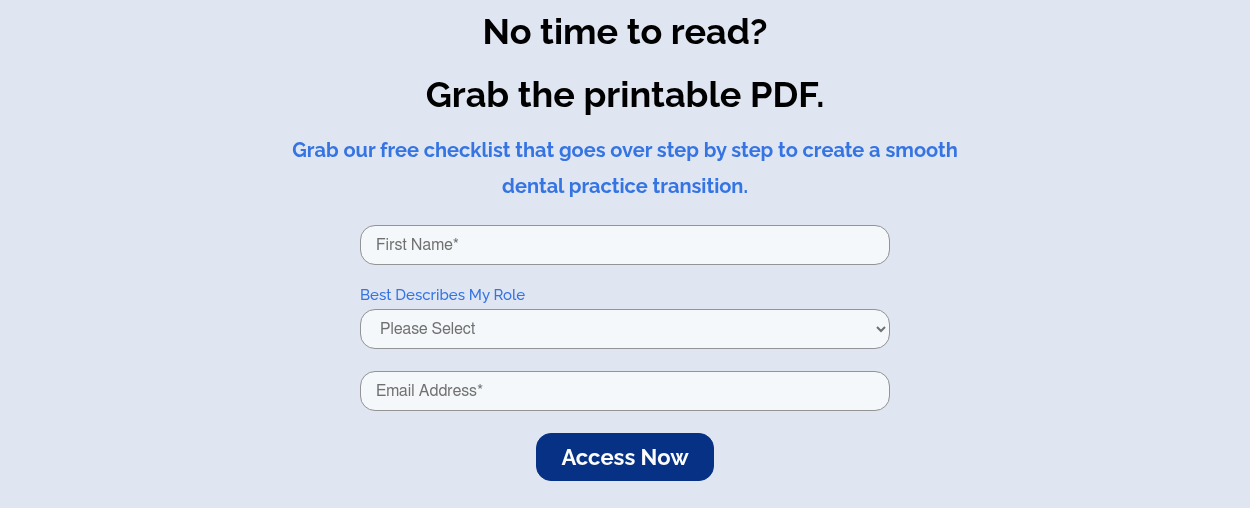Dental Practice Transitions: A Guide for Successful Dental Office Transitions

Whether you're adding a new dentist to your staff or planning to retire, having a smooth dental practice transition is essential for everyone involved. Even when you plan everything ahead of time, it can still be challenging to navigate the transition in a way that protects the existing practice. From evaluating buyers to hiring consultants, it's important to protect yourself.
Continue reading to learn all about transitioning a dental practice.
What Are Dental Practice Transitions?
A dental practice transition takes place when an existing practice hires a new dentist who will bring existing patients with them or when a practice owner decides to sell their practice. People who sell dental practices often do so as a precursor to retirement.
Dental practice changes can be quite complex and require extensive planning. A transition differs from a straight sale in that, typically, a new provider will be brought on either as a growth strategy or as an eventual exit strategy. Both instances may be true; for example, an established dentist might bring on a younger partner with the intention of eventually retiring, so that the other dentist can take over.
Another way of looking at it is that ADA practice transitions are driven by relationships. For a transition to be successful, existing practice patients and new practice patients must be made comfortable. Those relationships must be maintained or built, as should relationships between the new provider and existing practice staff members.

Types of Dental Practice Transitions
Dental practice sales and transitions can fall into a variety of categories, depending on how they are carried out and what the long-term goals are. Here are some transition types to consider.
- A buy-in happens when an outside practitioner buys into an existing practice. Usually, they will pay for a specified percentage of the ownership and there may be a clause allowing them to buy the remainder of the practice when the initial owner retires.
- A buy-out occurs when a buyer purchases the entire practice outright. This is usually accompanied by a short transitional period of 3 to 6 months, which helps ensure a smooth retirement from dentistry by allowing the new dentist to meet patients and build rapport before fully taking over.
- A merger involves the combining of two dental practices into one, larger practice, usually with equal ownership by both parties. Mergers may involve a longer transition and, like a buy-in, may include a buy-out option in the event one partner wishes to leave.
- Associate buy-ins happen when a practice associate is allowed to make payments over time that will culminate in the transition of ownership to the associate. This can be a useful long-term strategy and can make for a smooth transition if done properly.
- Associateship is the process of bringing in new associates. These associates may do a partial buy-in to the practice, and rules need to be clearly delineated to avoid power struggles.
- Affiliate transitions happen when a practice is sold to another entity, such as a DSO or a group. In most cases, the intent is for the original owner to exit, and a transition plan is designed with that in mind.
- Roll-ups involve the acquisition of multiple practices over time. The intention is to create a single, larger practice from the smaller practices acquired, and a new transition period is required after each acquisition.
Dental practice transitions can take only a few months or they may take place over multiple years, depending on the transition process that best suits the long-term goals of the practice.

Common Dental Practice Transition Mistakes
In any dental practice transition, the stakes are high. Not only are the buyer and seller exchanging money, but patient care must remain consistent if the transition is to be successful. Here are some common mistakes when transitioning a dental practice.
- Trying to have your cake and eat it, too. It's not reasonable to expect the new owner to pay you for an indefinite period or to finance your retirement on top of the purchase price.
- Deciding to sell before it makes financial sense to do so. You may want an early retirement, but unless the sale is going to make it possible for you to retire, you shouldn't move forward. The time to crunch the numbers is before you start the process of selling your practice.
- Not including an associate trial period. For any sale that includes a buy-in or an associateship, make sure to build in a trial period before the sale or buy-in is final, particularly if you and the associate haven't worked together before.
- Making handshake agreements instead of putting the agreements in writing. Any agreements you make, as a buyer or seller, MUST be in writing to protect all parties involved.
- Not spending money upfront to nail down the details. You might think you can wait to have your practice valued and negotiate the terms of the sale, but it's not a good idea. You should nail down the details early and, if necessary, put procedures in place for anything that needs to be negotiated closer to the date of sale.
- Not communicating with patients of both the existing practice and any incoming associate. A lack of patient communication can sink any practice. Long-time patients of a retiring dentist may need time and encouragement to get accustomed to the idea of trusting someone new. You can ease them into it by giving them plenty of time to acclimate and meet the new dentist.
- Making wholesale changes during the transition. Naturally, there will be some changes in any practice after a transition. However, it's important not to change too much, too soon. Don't raise your prices or bring in all-new staff right at the start.
The transition process is likely to take some time. Experts agree that during an ADA practice transition, creating a sense of continuity and reliability is essential.
Dental Practice Transition Checklist
Whether you are buying an associateship or flat-out buying a practice from another dentist, you will likely be eager to take advantage of practice opportunities as they arise. However, you can't afford to skip any of the essential steps on our dental practice transition checklist.
- Work with a practice transition expert to determine if it makes financial sense for you to buy or sell.
- If you're buying, decide where you would like to practice and work with your advisor to find viable practices to buy.
- If you're selling, get the word out to potential buyers.
- Do your due diligence before buying. You should look at:
- Patient treatments and treatment philosophies
- Review at least 10% of patient charts
- Discuss case acceptance and treatment philosophies to see if you are a good match
- Review office SOPs and any written documentation regarding office management or patient flow.
- Review billing and collection procedures.
- Review patient dental practice management software. Make a note of anything out of date.
- Review patient scheduling systems and procedures.
- Tour the facility and all treatment rooms, including equipment. Make sure to clarify what, if any, equipment will be included in the sale/transition.
- Review the lease for the existing office and make sure you understand the terms as they may apply to you.
- Get to know all practice staff and review compensation, including salaries and bonuses.
- Review referral sources.
- Work with your practice transition advisor to make an offer or to evaluate any offer made to you.
- Put the deal in writing. Make sure to include any specifics involving the transition, including how long it will last, what the obligations of the seller are, and how and when you will notify the patients.
- Sign and notarize the deal, and begin the transition process using the information you gathered during the due diligence.
We suggest making patient communication a priority during the transition. Sharing information with patients will make it easy for them to cope with changes as they come and will minimize the chances that you will lose them.
Transitioning Patients to a New Dentist
The most important aspect of ADA practice transitions is the process of transitioning patients to a new dentist. While consultants can get you through everything from reviewing practice listings to identifying practice opportunities, the buyers and the sellers must work together to ensure a smooth transition for the practice's patients.
There are several ways to approach patient notification, and you will likely need to implement more than one to get your new career off to a good start and make the transition a smooth one.
In-Person Notifications
The first option is to tell patients in person about the changes that will be happening. Timing can play a big role in whether you can notify patients in person. Any patient who comes into your office for an appointment in the window between 4-6 weeks before the sale is finalized should be told in person.
You may also want to make arrangements for long-time patients or patients who have anxiety about dental care to be told in person, if possible.
Email/Mail Notifications
If the practice has an active email list and patients are accustomed to receiving regular email updates, then you should send an email to every patient on your list about six weeks before the transition. The email should notify them of the date of the transition and who will be taking over the dental practice. You may also want to include some details about what the buyer will be doing. Mailing out postcards to every patient in your database with the same information is another great strategy to consider.
Invite Patients to a Transition Event
While you could certainly stop with the notification methods we have already discussed, we think it's a good idea to go the extra mile. Dentists can't survive without patients, and the existing patients are going to want to meet the dentists who will be caring for their teeth going forward.
Hosting a casual hello/goodbye event can give the practice's patients a chance to ease into the changes at hand. They can come into your practice, say goodbye to the dentist who is leaving, and meet the dentists who will make up the new team. An event like this is particularly important for patients who may have anxiety around dentists or who have been patients for a long time.
Dental Practice Transition Tips from the Experts
Let's close with some dental practice transition tips from the experts and successful dentists. Brian Halbert of Halbert Capital Strategies offers this piece of advice to sellers:
Define how you will help transition patients, how you will make sure your staff merges well with the other, and clearly understand how you can help grow revenue (and make sure you get a % of that growth).
Another key piece of advice that's useful to both buyers and sellers comes from Michael Roub, the managing partner at Inflection 360. He says:

One of the biggest considerations and challenges is to present financial and practice information in a manner that will give the buyer the utmost confidence in the quality and performance of the practice.
We would add that buyers should request and review full financials and KPIs before agreeing to terms. That way, there will be no surprises.
Dr. Robert Warren of Brooklawn Dental Associates believes transitions should focus on patients.

The most successful transitions allow sufficient time for the retiring doctor to introduce his or her patients to the new doctor, [and] retention of staff members will also make patients feel at home with the new doctor.
Warren also pointed out that maintaining a treatment philosophy that's consistent with the departing doctor can put patients at ease, knowing that they'll receive the same quality of care they have been receiving. Changes to treatments and technologies should be gradual to give patients time to adjust.
Final Word on Dental Practice Transitions
Dental practice transitions can be complex, but if you follow the steps and suggestions discussed here, you will have a smooth transition and set yourself up for success.
Titan Web Agency can help with many aspects of your dental practice transition!
Recommended Reading
- Ultimate Guide to a Dental Practice Rebranding [Free Checklist]
- Relocating Your Dental Practice? Here's Your Step-by-Step Plan [Free Checklist]
- Dental Office Names: How to Name Your Dental Practice
- The Ultimate Guide to Buying a Dental Practice
- Starting a Dental Practice: A Complete Step-by-Step Guide
- Dental Practice Valuations: A Guide for Dentists
- Relocating Your Dental Practice? Here's Your Step-by-Step Plan [Free Checklist]
- Dental Practice Financing: Business Loans for Dentists
- Dental CPA: Why Hire a Dental Accountant For Your Business?
Tyson Downs is the founder of Titan Web Agency, a company specializing in marketing for dental professionals. With an impressive track record of working with over 100 dental practices, Tyson has a deep understanding of the unique marketing needs within the dental industry.










.png)
.png)


